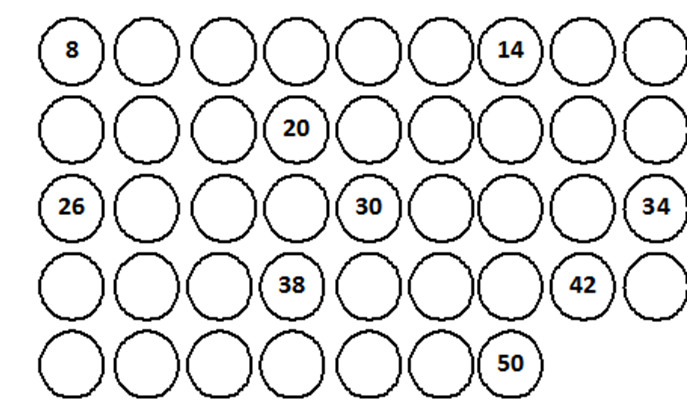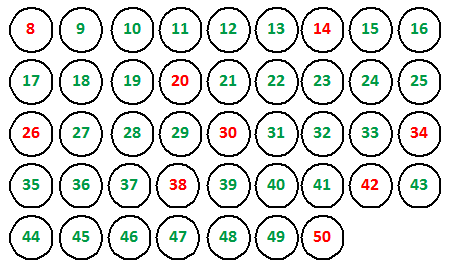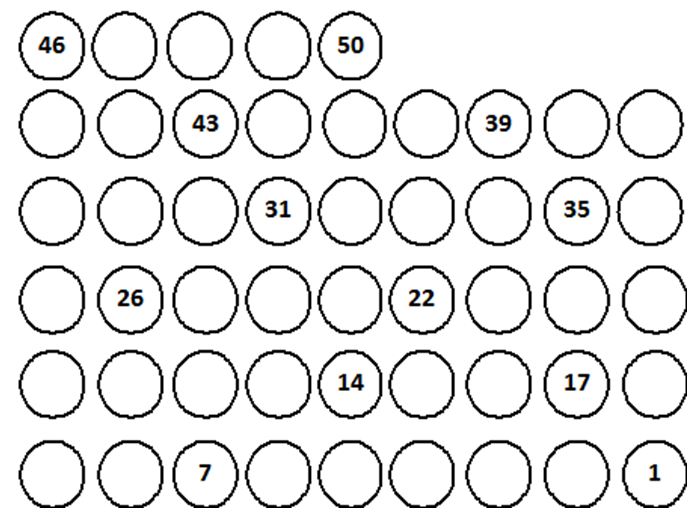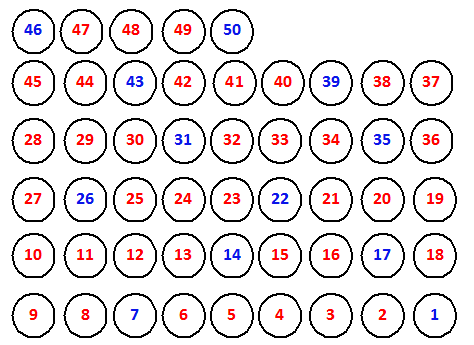CLASS-1
Count Forward Backward & Write Missing Numbers
1) COUNT FORWARD AND WRITE MISSING NUMBER

In above number series, we can observe that there are some numbers are mentioned such as 8, 14, 20, 26, 30, 34, 38, 42, 50. Now we have to find the other number which are lied in between these given numbers.
we have to recall the number forward starting from 8 up to 50, then numbers -
between 8 to 14 are = 9, 10, 11, 12, 13
between 14 to 20 are = 15, 16, 17, 18, 19
between 20 to 26 are = 21, 22, 23, 24, 25
between 26 to 30 are = 27, 28, 29
between 30 to 34 are = 31, 32, 33
between 34 to 38 are = 35, 36, 37
between 38 to 42 are = 39, 40, 41
between 42 to 50 are = 43, 44, 45, 46, 47, 48, 49
If we arrange or placed the obtained number then we find the series of number as given below-
for your kind information, all the given number are mentioned below in Red colour and required obtained numbers are mentioned in Green colours.

2) COUNT BACKWARD & WRITE THE MISSING NUMBERS

In above number series, we can observe that there are some numbers are mentioned such as 50, 46, 43, 39, 35, 31, 26, 22, 17, 14, 7, 1. Now we have to find the other number which are lied in between these given numbers.
we have to recall the number backward starting from 50 up to 1, then numbers between -
between 50 to 46 are = 49, 48, 47
between 46 to 43 are = 45, 44
between 43 to 39 are = 42, 41, 40
between 39 to 35 are = 38, 37, 36
between 35 to 31 are = 34, 33, 32
between 31 to 26 are = 30, 29, 28, 27
between 26 to 22 are = 25, 24, 23
between 22 to 17 are = 21, 20, 19, 18
between 17 to 14 are = 16, 15
between 14 to 7 are = 13, 12, 11, 10, 9, 8
between 7 to 1 are = 6, 5, 4, 3, 2
If we arrange or placed the obtained number then we find the series of number as given below-
for your kind information, all the given number are mentioned below in Blue colour and required obtained numbers are mentioned in Red colours.

Counting forward and backward involves listing numbers in ascending order (forward) or descending order (backward) with a consistent interval between consecutive numbers.
- Counting Forward: Counting forward means listing numbers in ascending order, starting from a given number and adding a fixed value to get the next number in the sequence. For example:
Starting from 1, counting forward by 2:- 1, 3, 5, 7, 9, ...
Starting from 10, counting forward by 1:- 10, 11, 12, 13, 14, ...
- Counting Backward: Counting backward means listing numbers in descending order, starting from a given number and subtracting a fixed value to get the next number in the sequence. For example:
Starting from 20, counting backward by 3:- 20, 17, 14, 11, 8, ...
Starting from 100, counting backward by 10:- 100, 90, 80, 70, 60, ...
Counting forward and backward is a fundamental skill learned in early mathematics education. It helps with number sense, understanding number sequences, and mastering addition and subtraction operations. The concept is further extended to more complex counting patterns as students progress in their mathematical learning.
Counting Forward:- Counting forward is the typical way of counting, where you start from a specific number and continue by incrementing one unit at a time. For example, counting forward from 1 would be: 1, 2, 3, 4, 5, and so on.
Counting Backward:- Counting backward is the reverse of counting forward. You start from a specific number and continue by decrementing one unit at a time.
For example, counting backward from 10 would be:- 10, 9, 8, 7, 6, and so on.
To count numbers backward or forward within a specific range, you can follow these steps:
- Counting Forward:Choose a starting number (e.g., 1) and an ending number (e.g., 100).Initialize a variable to store the current count (e.g., set count = 1).Start a loop from the starting number and continue until you reach the ending number.Print or store the current count at each iteration.Increment the count by 1 at the end of each iteration (e.g., count = count + 1).
- Counting Backward:Choose a starting number (e.g., 100) and an ending number (e.g., 1).Initialize a variable to store the current count (e.g., set count = 100).Start a loop from the starting number and continue until you reach the ending number.Print or store the current count at each iteration.Decrement the count by 1 at the end of each iteration (e.g., count = count - 1).